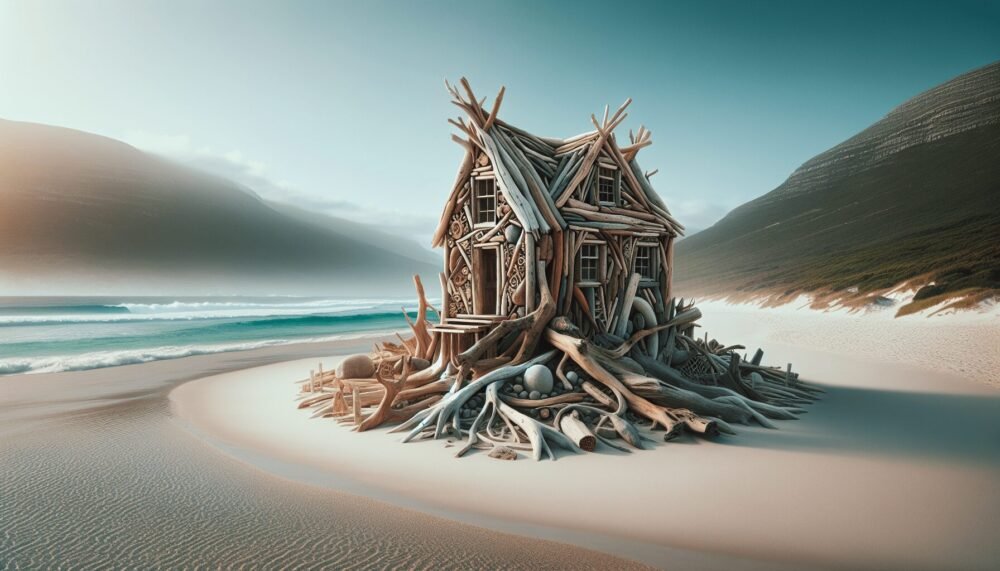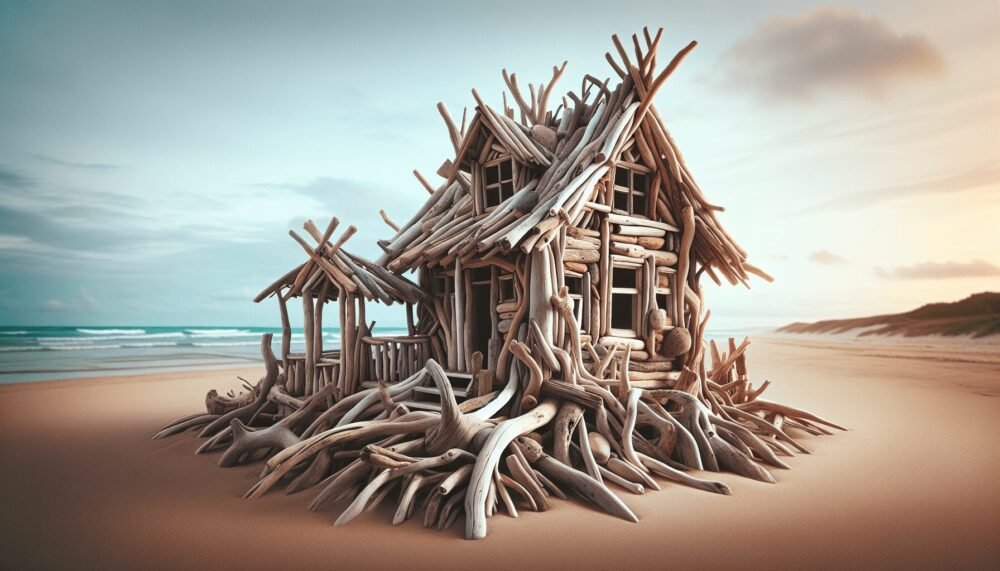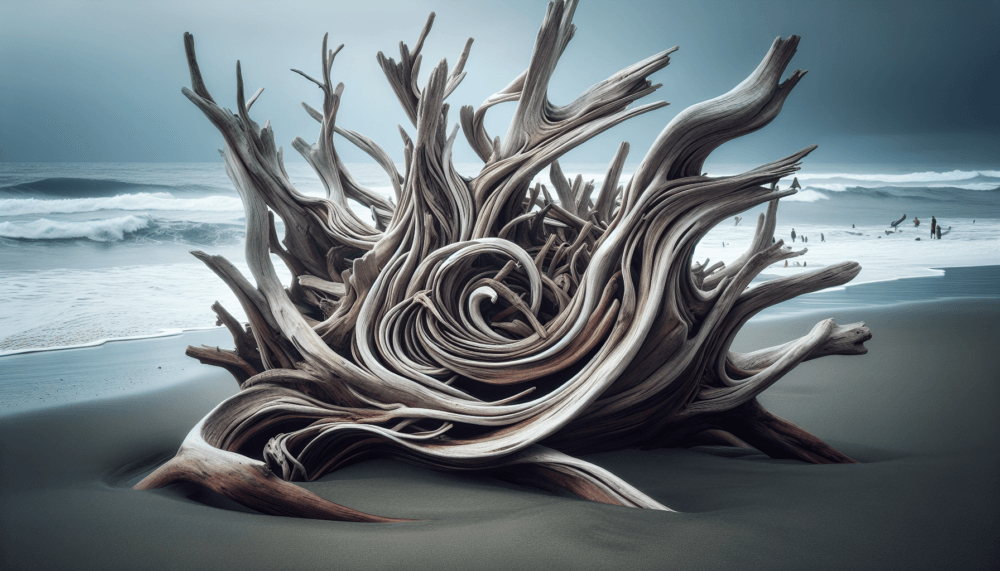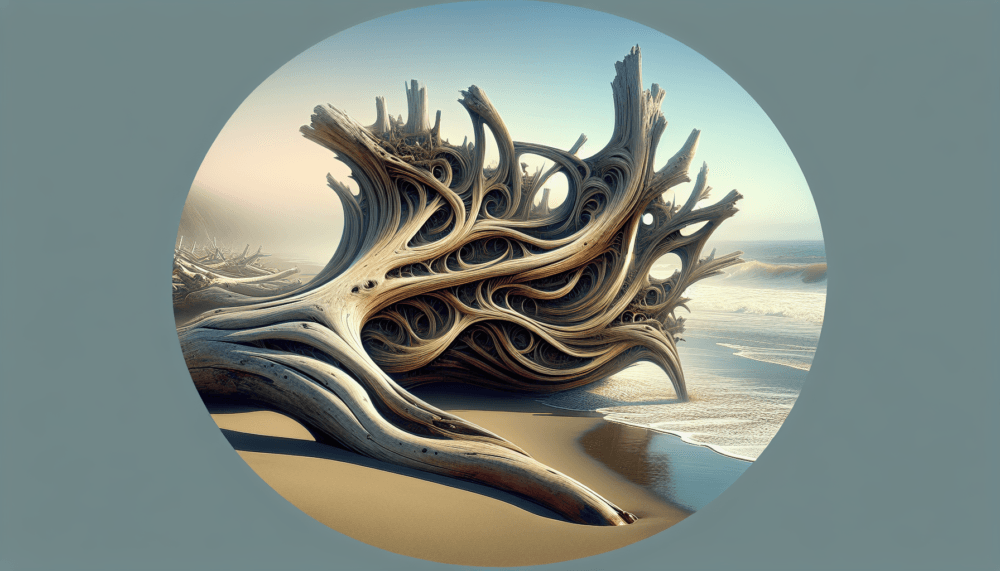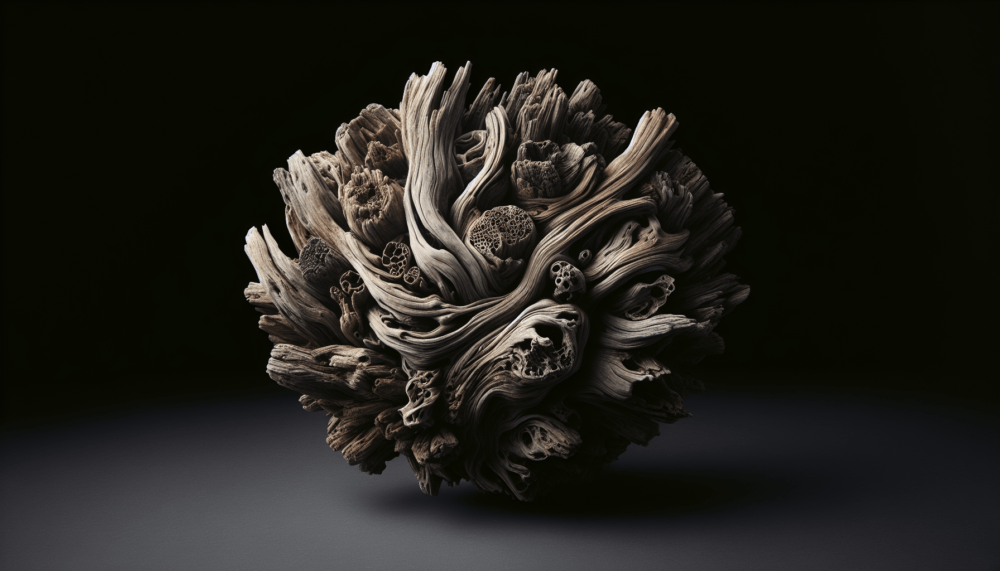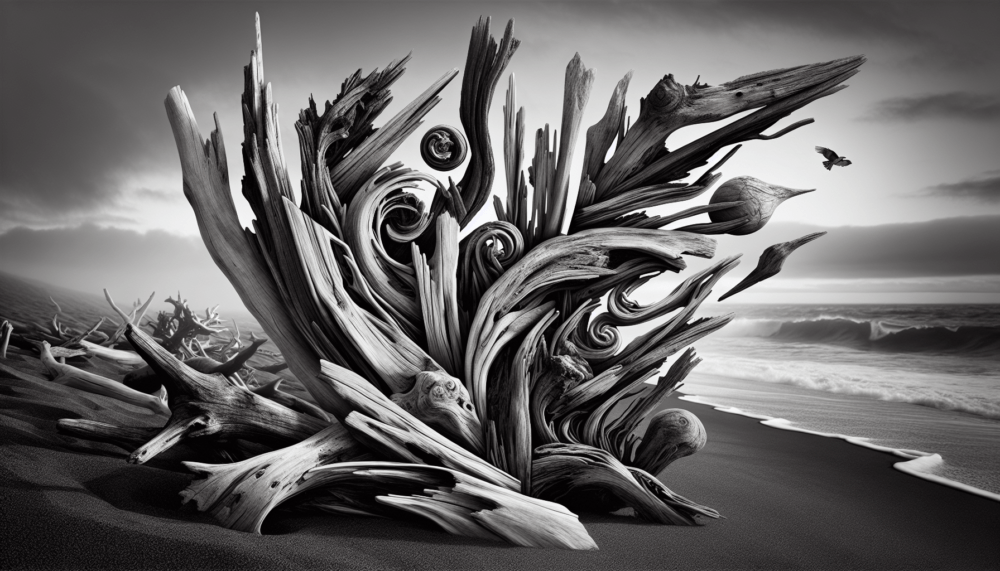Imagine walking along the beach, the soft sand beneath your feet, and the sound of crashing waves filling your ears. As you stroll along, something catches your eye – an extraordinary piece of driftwood, worn smooth by the ocean’s relentless caress. It’s not just any piece of wood; it’s a masterpiece in the making. Driftwood art sculptures, born from nature’s whimsy, are captivating creations that transform ordinary driftwood into intricately crafted works of art. With their organic shapes and unique textures, these sculptures breathe new life into discarded wood, reminding us of the beauty that can be found in even the most unlikely places. In this article, we will explore the enchanting world of driftwood art sculpture nature and delve into the artistry and craftsmanship behind these awe-inspiring creations.
Introduction to Driftwood Art Sculpture
Driftwood is a unique and beautiful natural material that has captivated artists and creatives for centuries. It refers to pieces of wood that have been washed onto shores or riverbanks by the force of the water. Driftwood can come from various sources, such as fallen trees, branches, or roots, and it undergoes a transformation as it weathers and ages, creating stunning and distinctive shapes and textures.
Driftwood art sculpture is the art of utilizing these water-worn pieces of wood to create beautiful and captivating sculptures. Artists use their creativity and craftsmanship to assemble pieces of driftwood into unique and expressive artwork that reflects the beauty and harmony of nature.
The connection between driftwood art and nature is profound. Each piece of driftwood tells a story of its journey, symbolizing the power of the elements and the cycle of life. Driftwood art celebrates the beauty and resilience of nature, and through it, artists and viewers alike can connect with the natural world on a deeper level.
Choosing and Sourcing Driftwood
When it comes to choosing and sourcing driftwood for art sculptures, there are various factors to consider. Understanding the types of driftwood is essential to create sculptures that are visually appealing and structurally sound.
Driftwood can differ in size, shape, and quality. It ranges from small branches to large logs, and artists often look for pieces that have interesting twists, knots, or weathered textures. Different types of wood also have distinct properties, such as hardness or durability, which can influence the sculpting process.
Exploring different sources of driftwood is also crucial. Driftwood can be found on beaches, riverbanks, or even at the bottom of lakes. Some artists prefer to gather driftwood themselves, while others may purchase it from suppliers or local artisans. Each source offers its unique selection of driftwood, allowing artists to find pieces that fit their creative vision.
When selecting driftwood for art sculptures, several considerations should be taken into account. Artists should examine the condition of the wood, ensuring it is sturdy and free from rot or insect damage. The size and weight of the driftwood should also be considered, as it can influence the scale and stability of the final sculpture. Taking these factors into consideration will help artists create artwork that is both visually appealing and structurally sound.

Tools and Materials for Driftwood Art Sculpture
To bring their artistic vision to life, driftwood artists require specific tools and materials. While the exact tools may vary depending on the artist’s preferred technique and style, there are some essential tools that are universally useful when working with driftwood.
Basic tools for working with driftwood include hammers, chisels, rasps, and saws. These tools allow artists to shape and modify the driftwood according to their desired design. Sandpaper and wire brushes are also essential for smoothing and refining the surface of the wood.
In addition to tools, additional materials can be used to enhance driftwood sculptures. Artists may choose to incorporate other natural materials such as stones, shells, or even metals to add contrast and texture to their artwork. Adhesives, such as wood glue or epoxy resin, are often used to securely attach pieces of driftwood together.
It’s crucial to prioritize safety when working with driftwood. As driftwood can be weathered and fragile, wearing protective gloves and eyewear is essential to prevent injury. Adequate ventilation should be ensured when working with adhesives or other chemicals, and caution should be exercised when handling sharp tools. By taking the necessary safety precautions, artists can create their artwork in a safe and enjoyable environment.
Techniques and Approaches of Driftwood Art Sculpture
Driftwood art sculpture offers artists a wide range of techniques and approaches to explore. While there are basic techniques that form the foundation of driftwood sculpture, artists can also experiment with creative approaches to create unique and innovative artworks.
Basic techniques for assembling driftwood sculptures include drilling holes to connect pieces with dowels or screws, using adhesives to secure joints, or binding pieces with wire or rope. These techniques allow artists to create stable and structurally sound sculptures while showcasing the natural beauty of the driftwood.
In addition to these basic techniques, artists can employ various creative approaches to sculpting with driftwood. Some artists prefer to maintain the natural form of the driftwood, using minimal alterations to highlight its unique shapes and textures. Others may choose to carve or shape the driftwood to create intricate details or specific forms. Experimenting with different techniques can unlock endless possibilities and allow artists to develop their distinctive style.
Preserving and treating driftwood is also an essential aspect of driftwood art sculpture. Some artists may choose to apply a protective coating, such as varnish or sealant, to enhance the longevity and durability of their artwork. Others may explore alternative preservation methods, such as bleaching or dyeing the driftwood, to create different visual effects. Proper preservation ensures that driftwood sculptures can withstand the test of time while maintaining their natural beauty.

Inspiration from Nature for Driftwood Art
Nature serves as a boundless source of inspiration for driftwood art sculptures. The shapes, textures, and organic forms found in driftwood reflect the diverse beauty of the natural world. By closely observing natural elements, artists can create sculptures that evoke the essence of animals, plants, and landscapes.
Driftwood often exhibits curves, twists, and knots that resemble the fluid forms of animals or the intricate patterns found in plant life. Artists can incorporate these natural forms and shapes into their sculptures, giving them a sense of movement and vitality. The weathered surfaces and textures of driftwood can also be utilized to mimic the rough bark of trees or the smooth, polished shells of sea creatures.
Using driftwood to depict animals, plants, and landscapes allows artists to create artwork that harmoniously blends with nature. By capturing the essence of these natural elements, driftwood sculptures evoke a sense of tranquility and connection with the environment. The imperfections and unique characteristics of driftwood further enhance the organic and authentic feel of the artwork.
Incorporating other organic elements, such as shells, stones, or moss, into driftwood sculptures can add depth and visual interest. These additional natural materials can complement the driftwood, enhancing the overall composition and creating a balanced and harmonious piece of art.
Environmental Awareness and Sustainability
As artists and creators, it is vital to consider the environmental impact of our materials and practices. When working with driftwood, ethical sourcing and promoting sustainability are of utmost importance.
Ethical sourcing of driftwood involves collecting it from sustainable and legal sources. Artists should avoid taking driftwood from protected areas or destroying habitats. Instead, they can opt for driftwood that has naturally washed ashore or purchase from suppliers who practice responsible collection methods.
Promoting sustainability in driftwood art can be achieved through utilizing reclaimed or salvaged driftwood. Repurposing driftwood that would otherwise be discarded reduces waste and makes a positive environmental impact. Artists can also raise awareness about the importance of protecting coastal ecosystems and the need for responsible driftwood harvesting through their artwork.
Using driftwood sculptures as a platform to raise awareness about environmental issues is another way artists can contribute to sustainability efforts. By incorporating themes or messages that highlight environmental challenges, artists can spark conversations and inspire viewers to take action.
Displaying Driftwood Art Sculptures
The display of driftwood art sculptures plays a vital role in showcasing their beauty and creating an impactful visual experience. Choosing appropriate locations is essential to ensure that the artwork is displayed in the best possible light and context.
When selecting a location for displaying driftwood sculptures, consider the scale and size of the artwork. Larger sculptures may require more open and spacious areas, such as garden landscapes, while smaller pieces can be displayed on shelves or coffee tables. The backdrop and surroundings should also be considered, as driftwood sculptures often blend harmoniously with natural elements such as plants or water features.
Tips for indoor and outdoor placement depend on the specific characteristics of the sculpture and its intended environment. For indoor placement, it is essential to consider factors such as lighting, temperature, and humidity to preserve the integrity of the driftwood. Displaying sculptures near windows or with proper lighting can enhance the shadows and textures of the driftwood, creating a captivating display.
For outdoor placement, weather resistance and stability are crucial considerations. Driftwood sculptures should be made of materials that can withstand various weather conditions, such as rain and sunlight. Securing the sculptures firmly to prevent movement or damage caused by wind or other environmental factors is also essential.
Enhancing the aesthetics of driftwood sculptures can be achieved through strategic lighting and background choices. Illuminating the sculptures with spotlights or accent lighting can create dramatic effects and highlight specific details. Backdrops that complement the colors and textures of the driftwood, such as neutral tones or natural materials, can enhance the overall visual impact of the artwork.
Driftwood Art Sculpture Artists and Their Works
Throughout history, numerous talented artists have embraced driftwood as a medium to create extraordinary sculptures. Their works showcase the diversity of styles, techniques, and interpretations that can be achieved with driftwood as a medium.
Renowned artists known for their driftwood sculptures include James Doran-Webb, Heather Jansch, and Jeff Uitto, among others. These artists have mastered the art of manipulating driftwood, creating lifelike animal sculptures, majestic horses, and intricate architectural installations.
Examining the styles and techniques of influential artists can provide valuable insights and inspiration for aspiring driftwood sculptors. By analyzing the composition, use of materials, and sculpting methods employed by these artists, one can develop a deeper understanding of the possibilities and potential of driftwood as an artistic medium.
Famous driftwood art installations around the world demonstrate the grandeur and impact that can be achieved with driftwood sculptures. Installations such as “The Driftwood Horses of Llanera” in Spain and “Driftwood on Sandbanks” in the UK showcase the beauty and creativity that can be unleashed through driftwood art. These installations often serve as landmarks or expressions of cultural identity, inviting both locals and visitors to engage with the natural world through the lens of art.
Driftwood Art Sculpture as a DIY Hobby
Driftwood art sculpture is not limited to professional artists. It can also be pursued as a fulfilling and rewarding hobby. Getting started with driftwood art allows individuals to unleash their creativity and connect with nature in a meaningful way.
To embark on driftwood art as a hobby, aspiring artists can start by gathering driftwood from their local beaches or riverbanks. Exploring different types and sizes of driftwood can spark inspiration and provide a foundation for creating sculptures. Basic tools such as hammers, chisels, and sandpaper are essential for beginners to shape and refine the driftwood.
A step-by-step guide can help beginners create their first driftwood sculpture. Beginning with sketching a design and choosing the right pieces of driftwood for the desired form, the process gradually involves drilling, attaching, and refining the sculpture. Following these steps allows beginners to develop their skills and gradually create more complex and intricate artwork.
Resources and communities dedicated to driftwood art provide valuable learning and sharing opportunities for hobbyists. Online forums, tutorials, and workshops offer guidance and inspiration, allowing driftwood artists of all skill levels to connect and exchange ideas. Learning from experienced artists and engaging with a community passionate about driftwood art can accelerate one’s growth and development in the field.
Driftwood Art Sculpture in Interior Design
The incorporation of driftwood sculptures into interior design can add a unique and natural touch to any space. With its organic forms and textures, driftwood art can seamlessly blend with various interior design styles, adding visual interest and creating a focal point.
In modern or contemporary designs, driftwood sculptures can serve as statement pieces that contrast with sleek surfaces and clean lines. Their weathered textures and natural shapes add depth and warmth to minimalist interiors, creating a visually striking contrast.
In rustic or coastal-inspired designs, driftwood sculptures can enhance the overall theme and evoke a sense of seaside charm and tranquility. Displaying driftwood sculptures alongside complementary elements such as nautical-themed accessories or neutral color palettes can create a cohesive and harmonious design.
To harmonize driftwood sculptures with existing decor, it’s important to consider the proportions and placement within the space. Grouping driftwood sculptures of varying sizes creates visual balance and prevents them from overpowering the room. Coordinating the colors and tones of the driftwood with other elements in the room, such as furniture or artwork, can also create a cohesive and harmonious design.
In conclusion, driftwood art sculpture offers artists and enthusiasts a unique way to connect with nature and express their creativity. By understanding the types of driftwood, selecting appropriate tools and materials, and exploring various techniques and approaches, artists can create captivating sculptures that reflect the beauty and harmony of the natural world. Whether as a professional endeavor, a hobby, or an element of interior design, driftwood art sculpture invites us to appreciate the intricate beauty of nature and deepen our connection with the environment.






